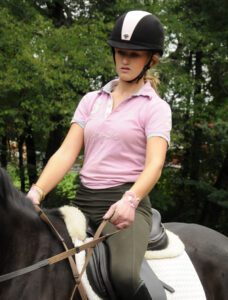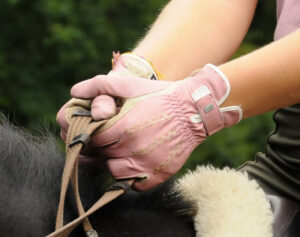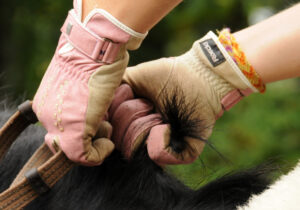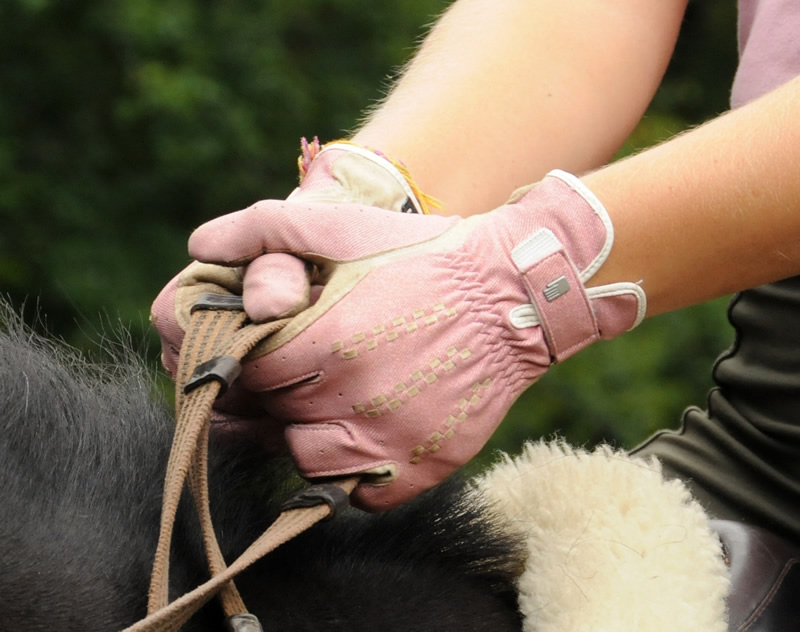Do your hands tend to wander apart when you ride? Does one hand drift more than the other? Do you lean to one side to turn instead of remaining upright? Here’s an easy exercise to find out just how much your need your hands to steer.

Next time you ride notice what you do with your hands when you ride circles and turns. Do you pull one hand back, down or out? Do you wait until the last minute to ask your horse to turn? Do you forget to turn from your seat even when you know this is what you should be doing?
Sometimes hands seem to have a mind of their own. You know you don’t want to pull on your horse. But you find that one hand takes over when you think your horse isn’t listening. Crossing your thumbs when you ride will give you feedback about how much you want to use your hands.
Many riders are very “one-sided” or “right-handed”. If you are one of those riders the following exercise awkward at first. Developing more awareness through non-habitual movements such as Feldenkrais® Awareness Through Movement® lessons will improve your coordination and use of both sides and allow your horse to go both ways more easily. You can find Feldenkrais classes and practitioners I your area by going to www.feldenkrais.com.
To feel what it is like doing non-habitual movements clasp your hands together. Notice which thumb is on top. Look at how you have your fingers interlaced. Unlace your fingers and interlace them again with the opposite thumb on top. How does this feel? What is different in your shoulders? Does your body feel different in places other than your hands?

Return to your habitual pattern. Notice what happens to your breathing, shoulders, and degree of overall comfort. Change the interlacing of your fingers back and forth a few times. Some people have to do this very slowly threading each finger in the new position. This is fine. It is your attention to the process that is important.
Does the non-habitual interlacing feel more comfortable after switching 10 times? Or do you still have to think about where each finger goes? If so continue to switch back and forth for a while. Stop and notice which way your fingers are interlaced. Is this the habitual or non-habitual way? Switch and feel what it’s like the other way. Notice that the non-habitual movement has become easier, more familiar and you don’t have to think about it so much. By paying attention to what you are doing you build new neural pathways in your brain so that you have a choice about which way to interlace your fingers. This concept can be used in many ways to improve your riding.
While mounted hold your reins in both hands. Cross your thumbs one over the other. Notice which way you crossed them. Keep the thumbs crossed as you ride. Do you want to pull both hands to the side to turn? Do you feel stuck, like you can’t turn at all? Do you want to let go of your thumbs because you feel like this is a “stupid lesson”? If you find yourself frustrated and your horse not listening it is time to reexamine your seat. Turning should come from your pelvis not your hands!

Catch a piece of mane with your pinky finger if you want to move your hands across the horse’s neck. This will not stop you but makes you more aware when your hand crosses the neck. To turn think of pointing your belly button where you want to go let your shoulders follow your seat. Repeat this lesson crossing your thumbs the non-habitual way. How is this different? Is it more difficult to turn your horse or keep you hands in the middle? Switch the thumbs back and forth until the non-habitual way is as comfortable your habitual way.
Use this Murdoch Minute to keep a drifting hand in place and prove that you can turn without pulling on your horse’s head. When both the habitual and non-habitual way feels the same you will be more balanced on your horse and remember to enjoy the ride!
Wendy Murdoch is available for lessons and clinics in the Northern Virginia region as well as throughout the United States. She teaches riders of all levels and disciplines how to improve the horse’s performance by improving their body position. On-line join Wendy’s Facebook group Fans of the Murdoch Method and find more articles, blog and her new book 50 5-Minute Fixes to Improve Your Riding, based on the Murdoch Minutes at www.murdochmethod.com




